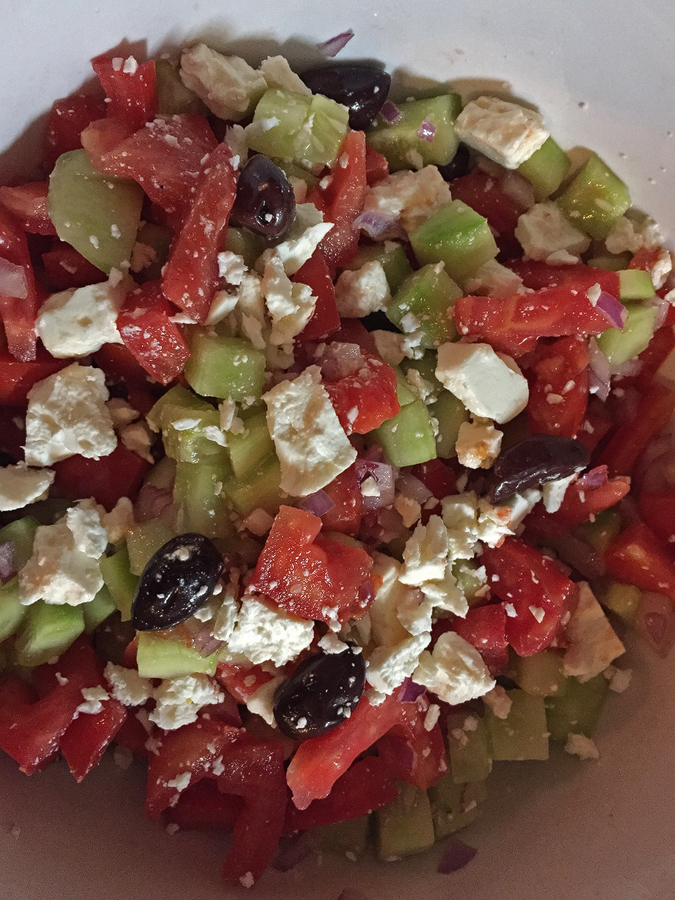
A well-constructed salad, eaten cold on a hot day, with a glass of flinty rosé and good bread, is more delicious than anything under the sun.
I ate my first Greek Salad thirty years ago, in Delphi and was instantly smitten by the extraordinarily refreshing combination of cool, crisp cucumber, sweet tomatoes, ripened in the summer sunshine, salty feta cheese, broken roughly into chunks, bitter black olives from Kalamata, olive oil and lemon juice.
The trouble is that the Greek Salad has undergone a familiar but tragic transformation. What happens is something like this: a famous traveller, Elizabeth David for example, eats a ravishingly delicious meal in a foreign country and later writes about it, from memory, exaggerating it merits. Tourists read the writer’s account and, on visiting the same country, are disappointed not to find it on offer anywhere. Enterprising restauranteurs start to serve not the original dish, but a simulacrum described by tourists, describing something the famous writer may once have eaten but probably didn’t. The result is inevitably a travesty and one that is compounded when a successful restauranteur claims to have discovered the One-True-Authentic-Recipe. The OTAR then enters the canon of dishes one must eat at least once, when on holiday in that country. Woe betide any restauranteur who dares stray from the OTAR, for he will be deemed inauthentic in all the guide books, and will swiftly go bust.
This is the fate that has befallen the Greek Salad. On every occasion that I ordered it, what I received was a bowl of cucumber sticks, quartered tomatoes, olives (usually very good), red onions sliced with the finesse of a haruspex conducting a ritual disembowelling, and a slab of cheese approximately the size of Mount Parnon. Often a sprinkling of dehydrated herbs had been added, a pointless coup-de-grâce, since the salad was already lifeless.
Uncooked, dried herbs taste like straw. Red onion wedges belong in a doner kebab van, parked in a layby beside the A1. And why must one hack chunks of feta cheese from a block, like a stonemason slaving away on the Parthenon?
Anyway, I think I can make a better Greek Salad than the Greeks, trying to please the tourists, can. As with all good food, the quality of the ingredients is vastly more important than the order or fashion in which they are put together. Having said that, in the best-made salads, all the components are of similar size.
Take one unimpeachable cucumber, peel it and cut it into cubes about half the size of the terminal joint on your thumb. Cut an equal quantity of ripe tomatoes into cubes of a similar size. If the tomatoes are really fleshy, you can scoop out and discard the seeds, using your fingers. Chop a red onion into small pieces, each no larger than a pea. Crumble about 200g of excellent feta cheese into small chunks. Mix these four ingredients with about 20 un-pitted olives from Kalamata. Dress with olive oil, lots of coarse salt and lemon juice. I like my Greek Salad quite lemony. Some recipes incorporate small pieces of stale bread, which has been rubbed with garlic. The result is something like the Middle Eastern salad fattoush and delicious but bread is, I think, an unnecessary addition.

Do not, for God’s sake, be tempted to add slices of green pepper or – shudder – a tin of sweetcorn. If you don’t like bitter, black olives, don’t leave them out. Instead, go down to Morrison’s and buy a Caesar Salad with crispy croutons and a sachet of ranch dressing. It will smell and taste like halitosis, but you’ll be a lot happier.
